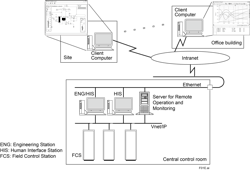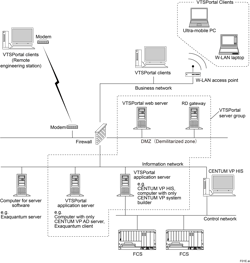Match scale and capability requirements of digital tools when implementing remote monitoring solutions
In decades past, having a remote operation, such as a well site or pumping station, meant having people working remotely, no matter how inhospitable the location. This was the case because there were few mechanisms to collect data or operate systems over a long distance, so checking equipment or making adjustments had to be done by human operators at the site.
Development of technologies such as remote terminal units (RTUs) combined with practical long-distance communication alleviated many of the personnel problems, but remote facilities were still subject to limitations not shared by more local operations. Fortunately, technologies have continued to evolve to the point that the concerns of remoteness, at least from an automation standpoint, have largely faded away. This is because many of the same digital tools and technologies used to control local systems can now extend virtually anywhere.
Some of the leading objectives and requirements for remote solutions implemented by process manufacturing companies are:
- Fewer site visits by human operators, improving overall employee efficiency, especially important due to COVID-19 travel restrictions.
- Reducing number of people working in harsh and hazardous environments.
- Addressing human resource issues due to retirement of skilled workers and lack of workers with requisite skills.
- Automating more functions locally and monitoring each remotely reduces the need for site visits.
- Ability to gather operational and diagnostic data easily and in real time.
- Control, but only by authorized and experienced users, from any location.
- Secure communication.
- Improved collaboration by linking decision makers and subject-matter experts who do not usually travel to remote sites with plant production and maintenance staff.
Recent advances support the basic functional requirements, plus they give users the ability to design configurations able to optimize performance of remote assets, rather than depending on an RTU as a one-size-fits-all solution. It is also important to understand that remoteness is not always a matter of physical distance. When an operator cannot access some part of a larger system, the same constraints are in effect whether the asset is many miles away or on the same site, so some solutions aim at bridging short distance gaps, as well as long ones.
These new technologies are part of larger digitalization programs and are built on Ethernet and IP networks, taking full advantage of their capabilities. Let’s look at several solutions that apply these digital tools and solve specific problems to improve remote operations.
Supporting field work
As mentioned, remoteness does not always involve distance. Sometimes, access is the prime concern, which can affect operators and technicians the moment they step out of the control room. The first example is a mechanism designed to extend a plant or unit’s distributed control system (DCS) out into the field so an operator can determine if the process and equipment are performing as desired.
For example, operators in a control room might be receiving conflicting data for the position of a strategic valve. The situation calls for sending a technician into the plant to see firsthand whether it is responding to commands from the DCS correctly. Using traditional techniques, this involves checking back and forth with the control room via walkie-talkie to discuss what the technician is observing. This sounds easy enough, but in hazardous areas, it may not be practical, and it draws operators’ attention away from the process.
A better way is to use a remote operation and monitoring function, as is available with Yokogawa’s CENTUM VP DCS platform. This function can be executed from remote computers, tablets or smartphones via the terminal service (TS) server of MS Windows Server (Figure 1).
The remote operation and monitoring function allows up to eight devices to connect with one central server simultaneously using Wi-Fi. The technician in the field can access an intranet tied to the control room, an engineering station or — with proper permissions enabled — a system outside the plant via the internet.
As long as the technician’s computer is connected to the human interface station (HIS) through the network, the operation and monitoring view on the HIS can be displayed on the remote device. The remote computer does not need to have the operation and monitoring applications installed. The technician can see what the valve is supposed to be doing with the same view as the control room operators, and then cycle the valve from the field if authorized to do so.
This HIS-TSE approach is easy to implement and inexpensive, provided the facility has effective IT infrastructure, especially an existing Wi-Fi network. In most situations, this approach is only used within the plant’s confines because it is difficult to provide sufficient security where there is potential for outsiders to break into the Wi-Fi network.
Access with strong security
Many use cases call for the kind of connectivity available with the HIS-TSE approach, but with the capability to reach beyond a single plant environment. For these situations, web portal server is the answer because its architecture allows for stronger security mechanisms (Figure 2). A system like Yokogawa’s versatile terminal service application portal (VTSPortal, Figure 2, top left) enables authorized users to access a DCS (CENTUM VP HIS), along with a variety of ancillary diagnostic and other support platforms, from thin clients (Figure 2, top right) via a wired connection or a wireless local area network (W-LAN).
Using this approach, any connection to the plant’s control networks must pass through a firewall for access control. This makes it possible to extend to more remote operations such as offshore platforms, wellhead sites, compressor stations and other unmanned facilities. Data and control functions can be accessed bidirectionally, including full HMI graphics and capabilities. The VTSPortal provides the same real-time performance, quality and functionality as the conventional physical environment — assuming adequate network speeds. Additionally, since a single host can support multiple thin clients, there is less hardware to support.
Compensating for limited bandwidth
Just a few years ago, companies did not anticipate the need for extensive data exchange with their remote sites and therefore often deployed low bandwidth communication infrastructure. This reflected the available technology rather than a deliberate oversight. For example, many offshore oil platforms still use satellite communication capable of only 2 MB per second. This limitation has changed little, even though the demands for data transfer have grown enormously, resulting in intolerable latency.
Since these situations may offer no alternative, Yokogawa has developed a wide area communication (WAC) router (Figure 3) designed to deliver the highest possible performance from these bandwidth-constrained networks. The WAC router enables a DCS to monitor and control remote equipment over a wide area network (WAN) using public communication lines, satellite links and similar networks. It provides the same high reliability and security as the Vnet/IP control network supporting conventional DCSs.
The WAC router compensates for limited bandwidth and transmission delays by prioritizing communications based on data type and target. For added reliability, the router has dual redundant communication modules. Each of these modules can be linked with the WAN by up to two communications lines. These may be the same or different types, such as a satellite link paired with a fiber optic cable. The router enables reliable and inexpensive monitoring and control of widely distributed facilities, such as land-based and offshore platforms used in oil and gas exploration and production.
Collaborative information server
The most comprehensive mechanism for remote monitoring is a collaborative information (CI) server because it supports integration of various facilities, systems and equipment scattered across all types of manufacturing sites, making it easy to share data and information. So how does it work?
A CI server is a cross-platform control and information system that integrates all aspects of operations, process control, data collection, data analysis and artificial intelligence (AI) in a central location (Figure 4). It links all sites — whether nearby or remote, manned or unmanned — with operators, engineers and management, regardless of their location. It supports communication over a variety of networks, including low-bandwidth options. It provides a real-time grasp and overview of production, people, output, inventory and activity at any production site, contributing to improved efficiency, productivity and stable operations at all sites and units.
A CI server supports several important communication platforms and protocols common to process manufacturing companies, including:
- OPC UA.
- Interface for cloud connections.
- HTML 5 for displaying data and HMI graphics via web browsers on any device.
- Open database connectivity industry-standard communication.
- Message queue telemetry transport, an Internet of Things (IoT) communication standard best suited for IoT, where a wide variety of data and information is exchanged among devices.
- Connection via legacy OT protocols such as OPC classic, Modbus and other leading PLC-based communication links.
These and other technologies make it possible to connect a wide range of equipment and systems, regardless of vendor, to support plants and facilities across an entire company. This enables system integration within single sites or units, as well as integrated management across more complex sites.
Data from all sources can be stored for long periods of time on redundant servers built on highly reliable and stable managed systems. Use of the IEC 61850 communication standard ensures a CI server can communicate directly with a variety of intelligent electronic devices, facilitating the connectivity of manufacturing sites and comprehensive operation systems.
This approach can create large volumes of data, which can then be analyzed using built-in AI tools. When creating production plans and key performance indicators, it is simple to view monthly, weekly and daily historical data — down to hourly or minute-by-minute data if such granularity is needed. In this way, the status of all units at all sites, nearby and remote, along with the data affecting each, can be grasped in real time, so production plans can be revised and executed as needed for whatever reason.
By eliminating data silos and taking a panoramic view of every manufacturing asset companywide, it is possible to adjust business-critical production plans and key performance indicators, while ensuring production and optimization are carried out using flexible plans, which can be adjusted and revised as needed.
Matching technology to requirements
Considering the enormous variety of remote integration use cases, it is clear that no single technology is ideal for every application. A simple wellhead monitoring approach may work well with a traditional field control node RTU solution, such as Yokogawa’s STARDOM FCN-RTU Autonomous Controller. The important takeaway is selecting a future-proof solution since the requirements of remote monitoring applications are likely to grow in scope and complexity. Whether tomorrow or next year, the remote operations challenges for process manufacturers will continue to evolve, presenting new opportunities for growth and optimization.
Miyu Nakagawa is a sales promotion manager at Yokogawa Electric Corporation. She joined Yokogawa in 2007 as a software engineer for integrated control system. Nakagawa leverages her experience to provide value-added solutions in line with customer requirements and the latest available technologies.
Yokogawa Electric Corporation
About the Author
Miyu Nakagawa
Miyu Nakagawa is a sales promotion manager at Yokogawa Electric Corporation. She joined Yokogawa in 2007 as a software engineer for integrated control system. Nakagawa leverages her experience to provide value-added solutions in line with customer requirements and the latest available technologies.




